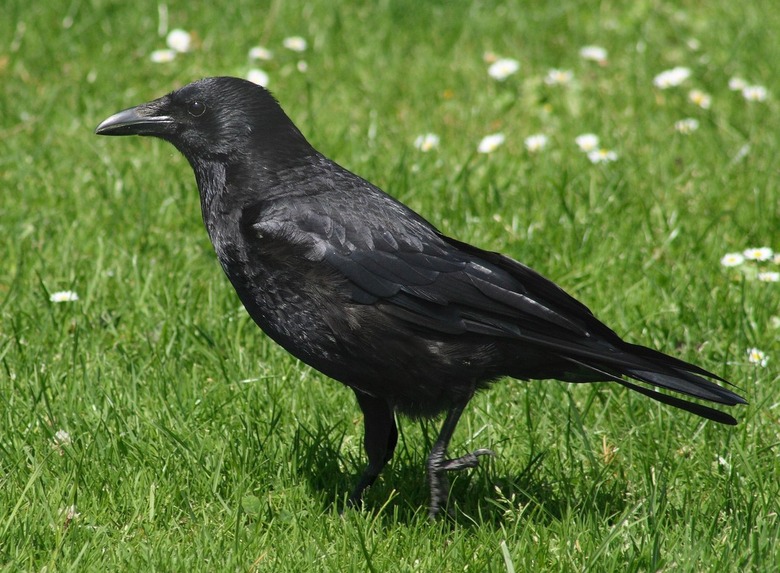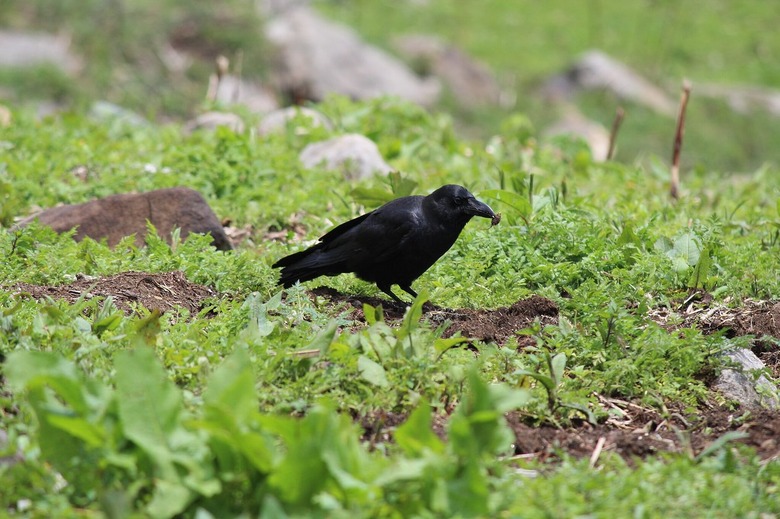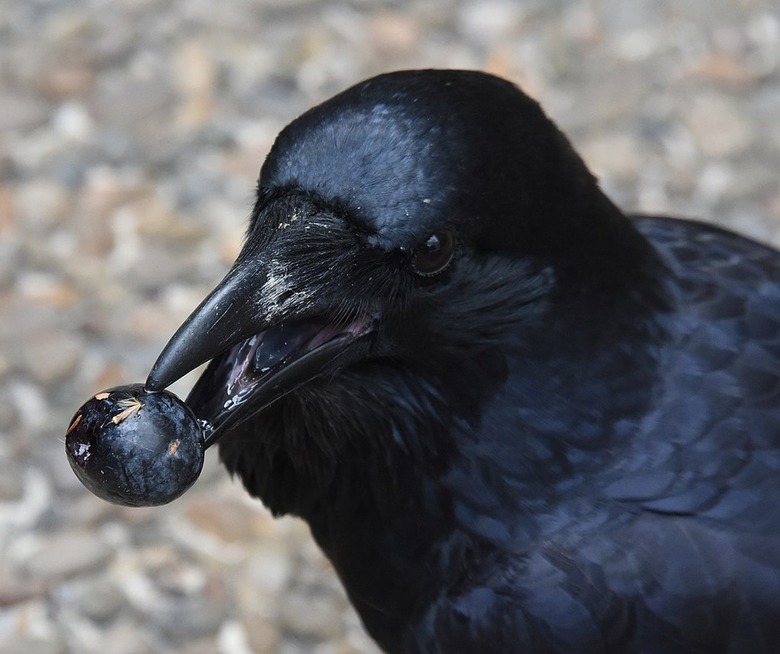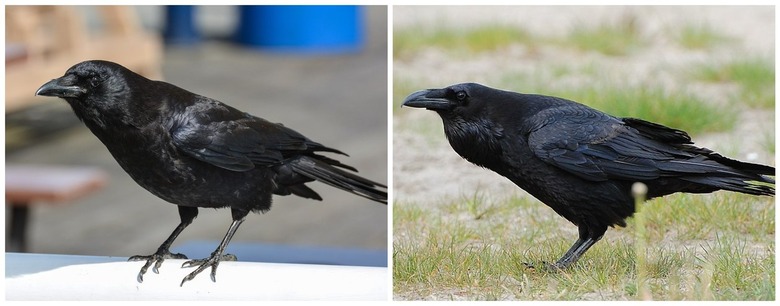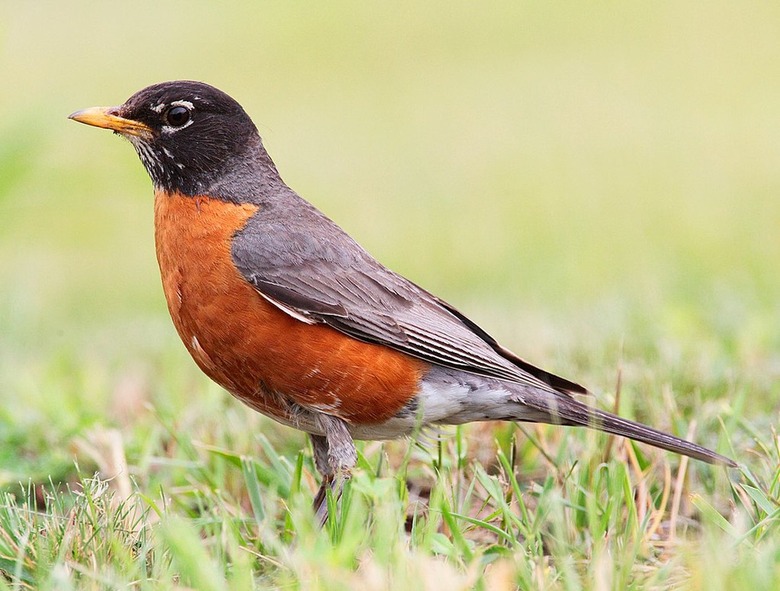How To Attract Crows — And Why You'd Even Want To In The First Place
Crows are one of the most common birds in America and have an intelligence level on par with chimpanzees, according to Audubon, which makes them fascinating to watch and interact with. If you want to learn how to attract crows to your yard, "basically, provide them food and water," says Dr. Kevin McGowan of the Cornell Laboratory of Ornithology, who has been studying crows for 35 years. From there, consider the birds' other needs, such as shelter and safety. Once you examine what they need to survive, you can start thinking about details, like what to feed crows and what they use to build a nest.
Why Attract Crows?
Why Attract Crows?
Like all members of the corvid family, crows are smart, but if their intelligence alone is not enough to inspire you to invite them into your yard, consider the advantages of providing them a home. For one thing, per the Humane Society of the United States, a single crow family can eat 40,000 caterpillars, armyworms, grubs, and other pesky insects in just one season — quite beneficial for anyone who is into gardening.
Crows are omnivores, and by transporting, storing, and eating seeds, they help renew landscapes through natural seed dispersal. They also eat carrion, so they can clean up roadkill or other dead animals, reducing the spread of disease and improving the scenery.
Also, consider that crows are good at remembering human faces. If you take the time to learn how to befriend a crow, McGowan says "they will get to know you as an individual, different from other people." They may reward you with kindness and friendship and possibly even small gifts, such as buttons, coins, cans, and rocks.
How to Attract Crows
How to Attract Crows
Using crow calls or decoy crows can attract these birds to your yard, but if you want them to stick around, be sure to provide the things they need for survival, such as water, food, and shelter. Take the following steps to get corvids to move onto your property.
1. Make a Safe Space
Start by creating an environment where the crows can feel safe. Eliminate loud noises, like slamming doors, wind chimes, bells, and noisy gates, to avoid scaring visiting crows. Even if you know your cat or dog would never hurt a fly, birds don't know this, so keep your pets indoors or in a separate area as much as possible so they don't scare away other creatures.
Remove anything that could scare away your feathered friends, especially things designed to scare birds, like shiny objects, owl statutes, and scarecrows. Finally, while you may be hoping to make friends with the birds, give them plenty of space, especially at first.
2. Pretend Other Crows Live There
Crows are highly social. If they think other crows live in your yard, they'll be more likely to check it out. Put out at least four crow decoys to make your space look inviting (make sure not to get a fake crow that looks dead or you could scare away the birds instead). Move the decoys periodically to keep your corvids engaged but only move the decoys at night or the crows will know they're not real.
You can also use a crow call or audio recordings of crows to attract them to your yard. These work best early in the morning or around sunset, which is when crows are most active.
3. Give Crows a Place to Relax
As social animals, crows appreciate a roosting area where they can spend time together. Ideally, a roosting place should be a tall, horizontal pole or a wire, like a tree branch or utility line, that is strong enough to support large birds. If you don't have any existing roosting spaces, add one by planting a new tree or installing a large pole with a crossbar at the top, ideally in a place you can see from your window so you can watch your new feathered friends.
4. Get a Birdbath
Like many birds, crows love birdbaths because they give them a place to drink, bathe, and cool off. They even enjoy soaking their food in the water to soften it before they eat. Crows particularly appreciate birdbaths on hot days. When buying a birdbath for corvids, choose one with high walls, which can hold more water and offer them a place to hang out next to the water.
5. Offer Crows Food
You might notice that you've never seen crow food in stores, which may leave you wondering, "What do crows eat?" According to McGowan, "They like an assortment of things, but it's perhaps best to offer them peanuts, unsalted and in the shell." However, he says crows also enjoy shelled peanuts because they like to bury the nuts in the ground, and "the shells make them easier to hide and help them stay preserved."
Aside from peanuts, some favorite foods of crows include:
- Dog food
- Eggs
- Popcorn
- Tater tots
- Cat food
- Meat scraps
- Birdseed
- Fruit
Feed the crows at the same time every day to establish a routine that will keep them coming back, ideally early in the morning or late in the evening. Put the food in the same place every time so they know where to find it. Pick a crow feeder that is heavy and sturdy enough for large birds and place it high up in an open area so they can easily see it when flying.
Alternatively, set up a compost pile to serve as an all-you-can-eat buffet for the birds, allowing them to choose between various food scraps and the insects that help decompose plant matter. When your compost breaks down, you can use it to help feed your plants.
Tip
Avoid giving the birds junk food, as it is unhealthy and could potentially attract pests, like rats.
6. Provide Nesting Materials
McGowan says crows like to nest in tall trees in an area that is somewhat concealed from the outside. If you want them to live in your yard, avoid cutting down any trees in which they may build homes. You may plant conifers, some of their favorite trees in which to nest, but remember that it may take years before these trees are large and sturdy enough to support a crow family.
To encourage them to construct nests on your property, put out materials. "Their nests are bowls of sticks lined with mud and grass and then with a softer inner lining of grape vine bark or fur," says McGowan. Leaving out items like pet fur, string, bark, pine needles, and twigs can help give them a head start on finding what they need to settle in.
Will These Techniques Also Attract Ravens?
Will These Techniques Also Attract Ravens?
It's said that ravens and crows are as different as leopards and tigers. "They look somewhat similar and act somewhat alike but have clear differences," explains McGowan. But just as leopards and tigers are both members of the cat family that would be equally enticed by a juicy steak, ravens and crows are both members of the corvus genus with similar dietary preferences. In other words, if you fill a feeder with foods that crows like, any ravens in the area would be quite happy to sit down for a snack.
Many other things that attract crows would also attract ravens, including birdbaths, good nesting spots, and nesting materials, such as strips of bark, pet hair, grass, sticks, and twigs.
As for recognizing whether you're looking at a raven or a crow, there are some subtle differences, like the fact that ravens have a slight blue, green, or purple sheen to their feathers, while crow feathers are more of a flat black. Ravens in flight have a diamond-shaped tail, while crow tails are triangular. However, the biggest tip-off is the bird's size. A raven is twice the size of a crow — about the size of a hawk. If you see a black bird in an area where ravens live and think it's way too big to be a crow, you're probably right. It's most likely a raven.
Do Crows Eat Other Birds?
Do Crows Eat Other Birds?
"Crows would like to eat songbirds, but they're not very well equipped for the job," explains McGowan. "They do eat eggs and nestlings of small birds, but they eat a lot more earthworms than eggs."
While some people hesitate to attract crows because they worry they will kill off the other songbirds (like cardinals, blue jays, and goldfinches) in the area, that's not a significant problem. Though crows do eat songbirds, Corvid Research reports that scientists have found that when crows are removed from a location, other predators move in and kill off just as many of the other birds. These same predators — including foxes, raccoons, hawks, owls, cats, and rats — also attack crows. Because birds, particularly chicks and eggs, are highly vulnerable and few make it to adulthood, most species breed frequently and lay many eggs.
Interestingly, in studies examining the role of crows on songbird populations, researchers found that having crows around actually helps other bird species 6% of the time. Ultimately, McGowan says, "[Crows] do not seem to affect other birds coming to a yard," so you don't need to choose between having songbirds or crows in your yard. You can enjoy both.
The Downsides of Attracting Crows
The Downsides of Attracting Crows
Though crows may not drastically harm songbird populations, that doesn't mean there aren't downsides to inviting them onto your property. Cons to attracting crows include:
- "They get up too early in the morning and make too much noise as soon as they wake up," says McGowan.
- They will poop on roofs, walkways, and vehicles.
- They may attack if you get too close to their nesting area or if you wrong them somehow, though they otherwise usually ignore humans.
- Because they can remember human faces and tell their young about their enemies, anyone who harms a crow may be dive-bombed by the birds for years to come.
- They may eat your crops, though many gardeners find the amount of fruits and vegetables they destroy is small compared to the number of destructive insects they devour.
- Your neighbors may not be happy with the arrangement because the birds are loud and "they leave peanut shells all over
the place," says McGowan. He warns that their habit of hiding their favorite snack all around the area can be a serious problem if any of your neighbors have peanut allergies.
The University of British Columbia Botanical Garden states that crows have also been known to rip up lawns to get to the larvae of the invasive European chafer beetle. In this case, the right solution isn't to focus on the crows but to use them as a red flag that your grass has a pest problem that needs to be addressed before the grubs destroy your lawn. Eliminate the beetle infestation and the crows will quickly leave your turf alone.
How to Get Rid of Crows
How to Get Rid of Crows
Interestingly, one of the most effective methods of eliminating crows is to provide them with an acceptable nesting site nearby. So, even if you don't want crows near your home, you may still benefit by learning how to attract crows to lure them away from your house. But act quickly if you see crows starting to build nests where you don't want them because once these corvids fully settle into a nesting spot, they are very difficult to remove.
Other ways to get rid of crows include:
- Eliminating any nearby food sources, including bird feeders.
- Using secure trash cans with tight-fitting lids and covering your compost so the crows won't have access.
- Playing loud noisemakers, such as ones that sound like fireworks.
- Covering crops with bird netting or putting shiny objects, like CDs, in your trees. You may be able to keep them out of your crops while still benefiting from their pest control abilities.
Tip
Crows and other pests may be afraid of owl statues for a short time, but you'll want to look into other methods that remain effective for a longer period of time.
